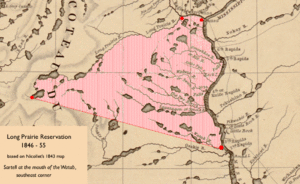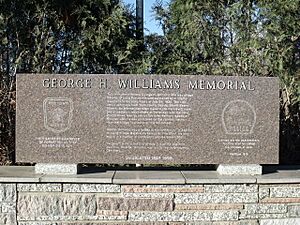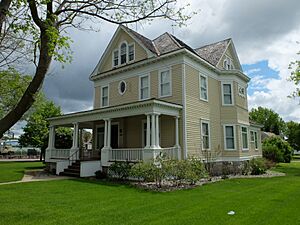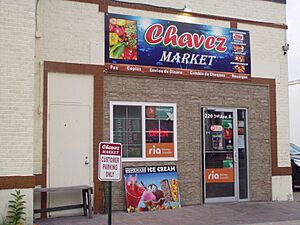Long Prairie, Minnesota facts for kids
Quick facts for kids
City of Long Prairie
|
|
|---|---|
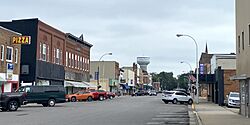
Central Avenue in downtown Long Prairie in 2024
|
|
| Motto(s):
"Expanding Our Horizons"
|
|
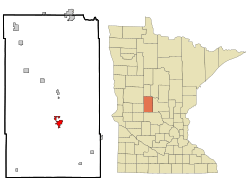
|
|
| Country | United States |
| State | Minnesota |
| County | Todd |
| Area | |
| • Total | 2.82 sq mi (7.31 km2) |
| • Land | 2.75 sq mi (7.11 km2) |
| • Water | 0.08 sq mi (0.20 km2) |
| Elevation | 1,303 ft (397 m) |
| Population
(2020)
|
|
| • Total | 3,661 |
| • Density | 1,333.21/sq mi (514.71/km2) |
| Time zone | UTC−6 (CST) |
| • Summer (DST) | UTC−5 (CDT) |
| ZIP code |
56347
|
| Area code(s) | 320 |
| FIPS code | 27-38060 |
| GNIS feature ID | 2395758 |

Long Prairie is a city located in Todd County, Minnesota, United States. It is the main city and the oldest town in Todd County. In 2020, about 3,661 people lived there.
Contents
A Look Back at Long Prairie's History
Long Prairie has a long history, starting with the Sioux/Dakota and then Anishinaabe/ Ojibwe Native American tribes living on the land. In 1846, the U.S. government gave a large area in central Minnesota to the Winnebago Indians (Ho-Chunk). This area was called the Long Prairie Reservation.
A spot in Long Prairie was chosen as the main place for the tribe. In 1848, the tribe moved there from Iowa. It was a tough journey, but once they arrived, they built a working village. They had homes, a school, and a church. Later, in 1855, the tribe moved again to southern Minnesota.
The city of Long Prairie was officially planned in 1867. It was named after the Long Prairie River. The Ojibwe/Anishinaabe people originally gave the river its name. Today, the United States Geological Survey has a special station on the river in Long Prairie to measure its flow.
Remembering Marshal George Williams
In July 1922, Long Prairie Village Marshal George Williams was on duty. He was helping to stop people who were involved in a bank robbery in a nearby town. Marshal Williams was a respected leader in the community. He was also the fire chief and helped with many community groups. A monument in Long Prairie honors his service to the town.
Exploring Long Prairie's Geography
Long Prairie covers about 2.67 square miles (7.31 square kilometers). Most of this area is land, with a small part being water. The Long Prairie River flows north through the city. Lake Charlotte is on the southern edge of the city. Venewitz Creek flows from Lake Charlotte and joins the Long Prairie River in town. Long Prairie is in the North Central Hardwood Forest Region of Minnesota.
Several important roads pass through Long Prairie. These include U.S. Highway 71 and Minnesota State Highways 27 and 287. Todd County Roads 5 and 38 also start in the city.
What is the Climate Like?
Long Prairie has a continental climate. This means it has long, cold winters and generally warm summers. Spring and fall seasons have mild weather, but temperatures can change a lot from day to day. In winter, temperatures can drop very low, sometimes to -40 degrees Fahrenheit. In summer, they can go above 90 degrees Fahrenheit. The growing season for plants lasts about 115 days.
| Climate data for Long Prairie, Minnesota (1991–2020 normals, extremes 1893–1918, 1937–present) | |||||||||||||
|---|---|---|---|---|---|---|---|---|---|---|---|---|---|
| Month | Jan | Feb | Mar | Apr | May | Jun | Jul | Aug | Sep | Oct | Nov | Dec | Year |
| Record high °F (°C) | 57 (14) |
59 (15) |
83 (28) |
95 (35) |
96 (36) |
101 (38) |
105 (41) |
104 (40) |
100 (38) |
90 (32) |
76 (24) |
71 (22) |
105 (41) |
| Mean daily maximum °F (°C) | 17.9 (−7.8) |
23.0 (−5.0) |
35.8 (2.1) |
51.2 (10.7) |
64.5 (18.1) |
74.5 (23.6) |
78.7 (25.9) |
77.0 (25.0) |
68.3 (20.2) |
53.8 (12.1) |
37.1 (2.8) |
23.2 (−4.9) |
50.4 (10.2) |
| Daily mean °F (°C) | 8.5 (−13.1) |
12.8 (−10.7) |
25.6 (−3.6) |
39.8 (4.3) |
52.9 (11.6) |
63.7 (17.6) |
67.8 (19.9) |
65.8 (18.8) |
57.3 (14.1) |
43.7 (6.5) |
28.6 (−1.9) |
15.2 (−9.3) |
40.1 (4.5) |
| Mean daily minimum °F (°C) | −0.9 (−18.3) |
2.6 (−16.3) |
15.4 (−9.2) |
28.3 (−2.1) |
41.4 (5.2) |
52.9 (11.6) |
56.9 (13.8) |
54.7 (12.6) |
46.3 (7.9) |
33.6 (0.9) |
20.0 (−6.7) |
7.2 (−13.8) |
29.9 (−1.2) |
| Record low °F (°C) | −45 (−43) |
−44 (−42) |
−37 (−38) |
−7 (−22) |
14 (−10) |
29 (−2) |
35 (2) |
28 (−2) |
16 (−9) |
3 (−16) |
−32 (−36) |
−39 (−39) |
−45 (−43) |
| Average precipitation inches (mm) | 0.98 (25) |
0.92 (23) |
1.54 (39) |
2.73 (69) |
3.47 (88) |
4.58 (116) |
4.64 (118) |
3.37 (86) |
3.29 (84) |
2.92 (74) |
1.46 (37) |
1.13 (29) |
31.03 (788) |
| Average snowfall inches (cm) | 9.7 (25) |
9.0 (23) |
8.6 (22) |
6.1 (15) |
0.2 (0.51) |
0.0 (0.0) |
0.0 (0.0) |
0.0 (0.0) |
0.0 (0.0) |
1.8 (4.6) |
7.1 (18) |
11.5 (29) |
54.0 (137) |
| Average precipitation days (≥ 0.01 in) | 9.2 | 7.2 | 8.4 | 10.3 | 11.9 | 12.9 | 12.2 | 10.5 | 10.6 | 11.1 | 8.0 | 9.1 | 121.4 |
| Average snowy days (≥ 0.1 in) | 9.0 | 6.4 | 4.9 | 2.7 | 0.1 | 0.0 | 0.0 | 0.0 | 0.0 | 1.3 | 4.4 | 8.9 | 37.7 |
| Source: NOAA | |||||||||||||
Fun at Lake Charlotte
Lake Charlotte is a large lake on the southern border of Long Prairie. It is about 144 acres (58 hectares) in size and 84 feet (25 meters) deep at its deepest point. The Minnesota Department of Natural Resources has studied the fish in the lake. You can find many kinds of fish there, including black crappie, bluegill, northern pike, and walleye.
On the north side of Lake Charlotte, there is a swimming beach and a big park. The city takes care of these areas. In the southwest corner of the lake, there is a public boat landing and a fishing dock. These are great spots for fishing and enjoying the water!
What Long Prairie Does: Industry and Media
Long Prairie is an important place for food processing. Several big companies have plants here. These include Dan's Prize, Long Prairie Packing, Minnesota Fresh, and Day Break Foods.
The local newspaper is called the Long Prairie Leader. It comes out every week and also publishes a monthly Spanish edition. For radio listeners, KEYL/KXDL has both AM and FM stations that serve Long Prairie and the surrounding area.
Discovering Long Prairie's Culture
Todd County Museum: A Journey into the Past
The Todd County Historical Society runs the Todd County Museum. It is located on the east side of the city's main business area. The museum building is on the same spot where the old Winnebago Indian Agency used to be.
This museum is a great place to learn about the county's history. It has many old items, photos, and documents. These show what life was like, what industries were important, and what the natural environment was like in the past.
Dr. George R. Christie House Museum
The Dr. George R. Christie House is another historic house museum. It is on the west side of the city's business district. This house was built in 1901 for Dr. George R. Christie. He was the first doctor in Todd County to have a license. The house was his family home and office.
After two generations of the Christie family lived there, the house and its original furniture were given to the city in 1976. It became a public museum. In 2006, the house was added to the National Register of Historic Places. This means it is an important historical site for health and medicine in the area. You can sometimes take tours of the house.
Who Lives in Long Prairie?
| Historical population | |||
|---|---|---|---|
| Census | Pop. | %± | |
| 1880 | 220 | — | |
| 1900 | 1,885 | — | |
| 1910 | 1,250 | −33.7% | |
| 1920 | 1,346 | 7.7% | |
| 1930 | 1,854 | 37.7% | |
| 1940 | 2,311 | 24.6% | |
| 1950 | 2,443 | 5.7% | |
| 1960 | 2,414 | −1.2% | |
| 1970 | 2,416 | 0.1% | |
| 1980 | 2,859 | 18.3% | |
| 1990 | 2,786 | −2.6% | |
| 2000 | 3,040 | 9.1% | |
| 2010 | 3,458 | 13.8% | |
| 2020 | 3,661 | 5.9% | |
| U.S. Decennial Census | |||
According to the 2010 census, there were 3,458 people living in Long Prairie. About 1,290 households and 816 families called the city home. The population density was about 1,325 people per square mile.
The people living in Long Prairie come from many different backgrounds. In 2010, about 81.8% of residents were White. About 29.9% of the population identified as Hispanic or Latino. By October 2021, over half of the students in the Long Prairie-Grey Eagle school district identified as Hispanic or Latino.
About 33.6% of households had children under 18 living with them. The average household had 2.58 people, and the average family had 3.29 people. The average age in the city was 34.1 years old. About 27.8% of residents were under 18, and 18% were 65 or older.
Famous People from Long Prairie
- Tom Barnard — A well-known radio host and voiceover artist.
- Barry Bennett — A former professional football player in the NFL.
- Charles P. Davis — A soldier in the United States Army who received the Medal of Honor.
- Jodi Huisentruit — A television news anchor.
- Jacob Wetterling — A young boy whose story brought attention to child safety.
See also
 In Spanish: Long Prairie (Minnesota) para niños
In Spanish: Long Prairie (Minnesota) para niños



